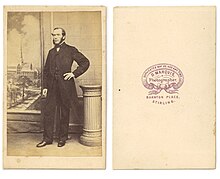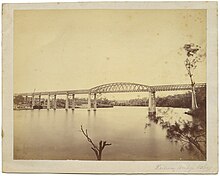User:PeterMarquisKyle/sandbox
Daniel Marquis (1829–1879) was born in Scotland where he trained and worked as a photographer from 1855 or earlier. In 1864 he emigrated to the British colony of Queensland and established a studio in Brisbane.[1] There he photographed the colonists, the buildings and townscapes and, most notably, an extensive series of portraits of Indigenous people.[2]

Early life
[edit]Daniel Marquis was born on 17 May 1829 in Glasgow, the second child of John Marquis and Isabella Marquis née McGregor, grocers, victuallers and spirit merchants. After leaving school Daniel worked in a cloth warehouse. He married Grace Murray in the Gorbals Parish Church in December 1851 and their first child, Janet Laird Marquis, was born in October 1852. By the time their second child, Isabella McGregor Marquis, was born in November 1855 Daniel was working as a photographer.[3]
A photographer in Scotland
[edit]
Daniel probably learned the recently-invented wet plate Collodion_process in one of the small number of photographic studios that were in Glasgow in the mid-1850s. He continued to make wet plate negatives and Albumen prints throughout his career. By June 1856 he had moved to Grangemouth and opened his own portrait studio. When his son John was born in June 1857 Daniel was recorded as a photographist in Hamilton. The family next moved to Stirling where Daniel set up a studio in Mill Lane (from 1858), then in King Street (from 1860), and later in Barnton Place (from 1862). Their eldest child, six-year-old Janet, died in 1858. A second son, James Murray Marquis, was born in Stirling in 1859, and in 1862 a third daughter, Grace Campbell Marquis, was born in 1862 and died three months later. Daniel’s wife Grace was sent away to receive care and treatment at Montrose Royal Asylum and Royal Edinburgh Hospital. These events may have prompted the family to leave Scotland.[3]
A photographer in Queensland
[edit]In December 1864 Daniel, his wife Grace, their children Isabella, John and James, and Grace’s younger sister Margaret departed Gravesend in the immigrant ship Flying Cloud. They arrived in Moreton Bay in March 1865 and settled in Brisbane.[3] By the beginning of 1866 Daniel had opened a studio in rented space in a new building in George Street, Brisbane.[4] In March 1867 he bought land at Lower River Terrace, South Brisbane,[5] where a cottage was built for the family.[6]
Portraits
[edit]
The main business of the studio was portraiture, mostly in the carte-de-visite format. In the glass-roofed operating room behind the building Daniel Marquis made lifelike images of the colonists. He posed the sitters with backdrops, furniture, drapery, head clamps and other accoutrements chosen to present them as handsome and respectable.[7]
Most of the studio’s clients were middle-class colonists—townspeople from Brisbane and squatters from outlying districts. In 1868 Daniel was appointed as photographer by Governor Blackall, a mark of social and professional approval.[3]

Indigenous people
[edit]Daniel Marquis was the most prolific photographer of Indigenous people in south-east Queensland in the 1860s and 1870s. More than seventy different subjects or poses are known.[2] These pictures were made for sale as stock images, generally in cart-de-visite format, which buyers collected in albums or posted to friends and family in other places. Use of hand-coloured enlarged prints from Daniel Marquis negatives by Richard Daintree at international exhibitions [Aird] Among the buyers of these portraits were the anthropologist Nicholas Mikluho-Maclay and the specimen collector Amelie Dietrich.[8] Through them and other collectors the photographs were acquired by European ethnographic museums including the Pitt Rivers Museum[9] at Oxford University, the Russian Museum of Anthropology and Ethnography in Saint Petersburg, and the Museum of Archaeology and Anthropology[10] at Cambridge University.
*Digital repatriation of Indigenous images.[11]
Views
[edit]
Daniel Marquis offered “views of gentlemen’s residences taken to order” and “stereoscopic and other views of Brisbane and neighbourhood.”[4] He captured many views of places in Brisbane, initially on 8½ x 6½ inch plates (whole-plate size) and, from the mid-1870s, on 12 x 10 inch plates. His customers had the albumen prints framed for display, or collected them in albums, such as one presented to Prince Alfred after his visit to Queensland in 1868. Daniel made a series of multi-plate panoramas from Wickham Terrace and Bowen Terrace that recorded changes in the Brisbane townscape through the 1870s.[3]
Death and legacy
[edit]On 23 January 1879 Daniel Marquis died of hepatitis.[12] The Imperial Photo Company bought the business and continued to sell prints from Daniel’s negatives, but ceased operating around the middle of 1880.[13]
Photographs by Daniel Marquis survive in private and public collections and provide an evocative record of colonial life in Queensland in the 1860s and 1870s. Notable examples are in the collections of the State Library of Queensland, the Queensland Art Gallery, and the National Gallery of Australia.
References
[edit]- ^ Rough, Brian. "Daniel Marquis". Capturing Brisbane: the City's first photographers 1855 to 1901. Retrieved 2024-02-27.
- ^ a b Aird, Michael (2015). "Aboriginal people and four early Brisbane photographers". In Lydon, Jane (ed.). Calling the Shots: Aboriginal Photographies. Canberra: Aboriginal Studies Press. OCLC 870331664.
- ^ a b c d e Marquis-Kyle, Peter (November 2021). "Daniel Marquis: a Scottish photographer in Brisbane". Queensland History Journal. 24 (11): 997–987.
- ^ a b Pugh, Theophilus (1866). Pugh's Queensland Almanac, Directory, and Law Calendar for 1866. Brisbane: Pugh.
- ^ Memorandum of conveyance registered 7 March 1867.
- ^ The Official Post Office Directory of Queensland 1874. Brisbane: F F Bailliere. 1874.
- ^ "Cartes-de-visite by Daniel Marquis". www.marquis-kyle.com.au. Retrieved 2024-02-27.
- ^ Sumner, Ray. "Photographs of Aborigines of north-east Australia: a collection of early Queensland Aboriginal photographs, made by Amalie Dietrich for the Museum Godeffroy" (PDF).
- ^ "Photograph collected by Amalie Dietrich". Pitt Rivers Museum.
- ^ "P.64351.RDG". collections.maa.cam.ac.uk. Retrieved 2024-02-28.
- ^ "Returning Photos: Australian Aboriginal Photographs from European Collections". Retrieved 2024-02-27.
- ^ Register of Deaths in the Colony of Queensland.
- ^ Rough, Brian. "Imperial Photo Company". Capturing Brisbane: the City's first photographers 1855 to 1901. Retrieved 2024-02-27.

